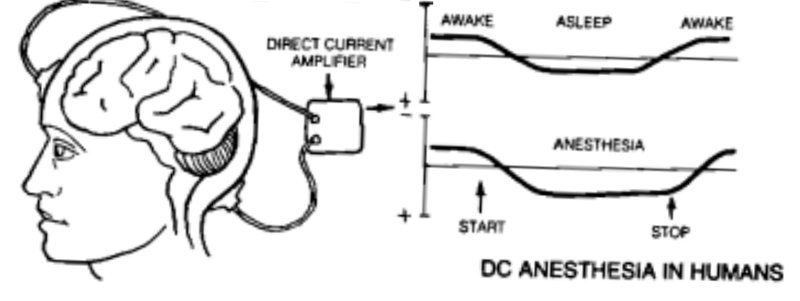Most of you readers of DMT Quest are familiar with the concept of the “Near Death Experience” (NDE). It takes place when a person comes extremely close to dying and in the process experiences visual and auditory “hallucinatory” phenomena. Sometimes people describe traveling through a tunnel of light where they eventually meet deceased loved ones or even “spiritual” beings. In other cases, people describe floating above their bodies and being able to travel as if they were a “ghost”.
In the piece, “Near Death Experiences & Déjà vu” we touched upon the brain activity of live rats following cardiac arrest (heart attack). The findings were as follows:
“We identified a transient surge of synchronous gamma oscillations that occurred within the first 30 seconds after cardiac arrest and preceded isoelectric electroencephalogram. Gamma oscillations during cardiac arrest were global and highly coherent; moreover, this frequency band exhibited a striking increase in anterior–posterior-directed connectivity and tight phase-coupling to both theta and alpha waves. High-frequency neurophysiological activity in the near-death state exceeded levels found during the conscious waking state. These data demonstrate that the mammalian brain can, albeit paradoxically, generate neural correlates of heightened conscious processing at near-death.”
This brain activity indicates that there is increased processing power taking place in the brain during NDE’s… greater than those experienced during “normal” waking states.
Switching gears for a moment.
While many people tend to believe that there is only one objective reality, there has been some interesting public discourse regarding the topic of perceptual differences. In 2015, a viral sensation regarding a picture of a dress showcased a clear difference in large percentages of the population in terms of the subjective nature of visual perception. Earlier this year (in 2018), a similar viral occurrence took place but in auditory format as the population discussed their interpretation of a sound (either “Yanny” or “Laurel”). These instances of public debate/conversation regarding simple yet clearly different interpretations of sensory stimulus are necessary to further understand the “human experience”.

A 2017 study published in Scientific Reports would measure the brain activity of people as they conversed with each other. 15 pairs of complete strangers of the same sex were used for the study. The pairs of participants would follow a script (general conversation) and took turns playing the roles of speaker and listener. Utilizing electroencephalography (EEG) equipment, the scientists measured the movement of their brainwaves simultaneously and confirmed that their oscillations took place at the same time.
The researchers concluded: “The brain synchronization in delta and theta bands was mediated by the speech signal, since entrainment occurred between the neural systems of the senders and the receivers, but also between their brains and the shared message, through entrainment to the audio envelope. Interestingly, some of the synchronization pattern found in the alpha and beta band seems to emerge directly from the mutual interaction of the pairs, without being mediated by the physical properties of speech (i.e., a “pure” instance of brain-to-brain entrainment). These results strongly emphasize the social essence of verbal communication and invite a paradigm shift that does not exclusively focus on the study of individual brain activity in isolation as a proxy for understanding the neural bases of linguistic communication.”

Earlier this year (in 2018), the University of Western Ontario performed a study in conjunction with McMaster University’s LIVELab measuring the effects of musical stimulus on brainwave activity when in group settings. The study would include 24 participants wearing EEG caps exposed to three different parameters at different times: 1. a live band with a large live audience 2. a replica of the live band acoustics with video of the band on a big screen but still sitting within a large live audience 3. the same experience as #2 but instead of a crowded concert environment, it was only a few EEG participants sprinkled amongst the seating. The researchers found that the brainwave synchronization amongst participants took place at the greatest level during live performances, less during the recorded performance, and the least amount during the recorded performances observed in semi-isolation.
A 2017 study in the journal Current Biology would measure the brain activity (via EEG) of 12 high school students in a classroom. The researchers would take 11 measurements over the course of a semester during regular classroom activity. In addition to the brainwave data, the students completed pre and post-class questionnaires on a number of factors such as how focused they were on any given day, how much they enjoyed their teacher, how much they liked each individual student around them, and their satisfaction levels with different group activities they performed in class. Following the analysis of the brainwave data and results of the questionnaire, it was found when students’ brain waves were more in sync with one another, they were also more engaged with the class. Additionally, the more in sync they were, the more likely they were to have given the course and its teacher high marks.
Thus far it seems as though there is a brain wave “mirroring” synchronization of sorts when people are engaged in conversation, listening to live music together, and attentively learning in a classroom setting. It appears as though this indicates that these people are having very similar experiences in terms of perception.
Let us continue…
A 2017 study published in the journal Social Cognitive and Affective Neuroscience observed the effects of territorial threats on brain wave activity. The study included 90 students (from China) split into pairs and divided into 3 groups. One group had to read an article about Japan increasing military pressure on China, another group had to read about Eritrea’s possible military aggression toward Ethiopia and another group had to read an article about China that did not contain any type of threat. Hyperscanning electroencephalography (EEG) technology was utilized which simultaneously measures brain activity among interacting subjects. It was found that synchronization of gamma wave oscillations are enhanced when people are under high threat, and increased gamma wave synchrony is associated with greater social coordination.
A 2012 study in the journal Frontiers in Human Neuroscience would measure the brain wave activity of 12 duets playing the guitar. The researchers wanted to find out whether musicians’ brains would synchronize if the two guitarists were not playing exactly the same notes, but instead played different voices of the same song. The duets were asked to play a sequence from the “Sonata in G Major” by Christian Gottlieb Scheidler a total of 60 times, and the duet partners were given variable tasks. It was found that phase locking and phase-coherence connection strengths (analysis restricted to delta & theta bands) were enhanced at frontal and central electrodes during periods that put particularly high demands on musical coordination.

A 2018 study in the Proceedings of the National Academy of Sciences would observe the effects of hand holding amongst couples. The experiment would include 22 couples (heterosexual) from 23 to 32 years old who had been together for at least one year. The scenarios included sitting together but not touching, sitting together while holding hands, and sitting in separate rooms. These scenarios were repeated as the woman was subjected to mild heat pain on her arm. It was found that merely being in the same room increased synchronization of the alpha band in the couples. However, this synchronization increased significantly more when the couples held hands and the most when the couples held hands as the woman was subjected to mild heat pain. Further tests observed that the greater the level of the male partner’s empathy for their partner’s pain, the more their brain activity synced which increased the suppression of her pain. An additional part of the study published in Scientific Reports also observed that increased heart rate and respiratory pattern synchronization occurred when the couples held hands.
A 2017 study in the Proceedings of the National Academy of Sciences would measure the brain activity of infants and adults as they interacted with each other. The study included 36 infants and utilized two experiments in order to measure the effects of eye contact. In the first experiment, the infants watched a video of a female adult (whose brainwave pattern had been recorded) sing nursery rhymes. First, the adult looked directly at the infant while singing, then she turned her head away to avoid eye contact while still singing, and finally she turned her head away but her eyes looked directly back at the infant. The researchers found greater synchronization when the adult’s gaze met the infant compared to when the gaze was averted. However, the greatest synchronization took place when the adult turned their head away but still kept their gaze looking directly at the infant. The researchers found that direct gaze produced higher interpersonal neural synchronization than indirect gaze in both theta and alpha frequency bands.
The second experiment utilized a real adult female to replace the video. In this experiment the adult sang nursery rhymes and either made direct eye contact with the infant or avoided eye contact. This time, EEG equipment was utilized in real-time to monitor the brainwaves of both participants. It was observed that both infants and adults became more synchronized to each other’s brain activity when mutual eye contact was established. This occurred even though both subjects could see each other at all times. The researchers say that this shows that brainwave synchronization isn’t just due to seeing a face or finding something interesting, but about sharing an intention to communicate. The researchers found that similarly to the first experiment, direct gaze produced higher interpersonal neural synchronization than indirect gaze in both Theta and Alpha. However, it was also observed that the effect of the gaze was bidirectional. During direct gaze, the adult had a stronger influence on the infant, and the infant also had a stronger influence on the adult.

A 2016 study in the journal Neuroimage would utilize functional magnetic resonance imaging (fMRI) equipment in order to measure the activity in the human brain induced from sustained eye contact. The study involved 48 pairs of participants who were strangers. The researchers observed enhanced eye-blink synchronization based on mutual gaze was positively correlated with inter-individual neural synchronization within the right inferior frontal gyrus (IFG).
In addition to the brain wave synchronization during conversation, live music, and the classroom setting… the above studies indicate that this entrainment also takes place during moments of group threats, duets operating musical instruments during concert, hand holding amongst couples, and sustained eye contact. At this point, it seems clear that there are multiple pathways in terms of inducing brain wave entrainment between 2 or more people.
Back to the original topic at hand… what does any of this have to do with NDE’s or the title of the piece “Shared Death Experiences & DMT”?
After reviewing the studies above, it appears as though there is the possibility that synonymous perceptions coincide with the synchronization of brain activity measured via EEG. We speculate further that there is the potentiality that specific brainwave frequencies coincide with specific ratios of neurological biochemical release that coincides in synchronous fashion with alterations in perception. The reason why we decided to dive into the topic of the “Shared Death Experience” is based on the following lecture by Dr. Raymond Moody.
In this presentation, Dr. Moody describes an occurrence he experienced while in medical school in the 1970s (for his M.D.). During this time he had already acquired his PhD in philosophy and had built a reputation for the study of Near Death Experiences. I will attempt to summarize the story he presented regarding the Shared Death Experience as follows:
“I was in the college bookstore and was approached by a well known female psychiatrist/professor. She stated, “I wanted to meet you because of some mentation I had when I was resuscitating my mother.” We then went to her office and she told me about the recent situation of having to try and unsuccessfully resuscitate her own mother. She described trying to help her mother and at the moment of death, she experienced what could be classified as an “Out of Body Experience”. She could see her own body down besides her mother’s body (now deceased). At this point she describes the feeling as being very disoriented as she was “trying to get her bearings”. As she continued to survey the situation, she became aware of her mother also being “Out of Body” next to her in “spirit” form. She then saw an intense light where people who she knew had passed away (friends/relatives of her mother) emerged from. She stated that she then said her goodbyes to her mother and that her mother began to recede into the intense light alongside the other figures. Next, the light began to fade in a spiral fashion and it disappeared leaving the woman standing next to the deceased body of her mother.“
This story was the first case of a “Shared Death Experience” that Dr. Moody had been exposed to. His research regarding the “Shared Death Experience” (SDE) continued and he found that in some cases, the SDE included even richer detail into what might be described as the “afterlife”. I’ve provided several videos of Dr. Moody discussing these transpirations at the bottom of this piece.
The question that DMT Quest has now is… if the “Near Death Experience” occurs based on significantly altered and quite possibly enhanced brain activity during the moments of death, is it possible that the “Shared Death Experience” mirrors this brain activity? We’ve included a number of studies indicating that brain waves between people can synchronize according to various parameters including hand holding, eye contact, empathy, attentiveness/engagement, conversation, and music. When a loved one is actively dying, it would seem that there would be a significant increase in the amounts of empathy, eye contact, hand holding, and attentiveness that a person would exude.
If there is a synchronization of brain activity during SDE’s, that would indicate that brain-to-brain communication is definitively a possibility for humans. This is obviously no surprise for DMT Quest as we’ve touched upon this notion throughout the site and have presented protocols to induce direct experience in the piece “Telepathic Training Wheels”.
As we’ve mentioned quite extensively in the past, author of “The Body Electric”, Dr. Robert O. Becker utilized a direct current (DC) measurement in order to measure changes in brain activity. This differs from the EEG being that instead of citing different types of brain waves coinciding with specific states of consciousness, Becker would observe that changes in the direction of the current and the voltage associated with that direction dictated the level of consciousness.

Here is an excerpt from “The Body Electric” for a more clear understanding:
“Charlie, Howard, and I decided to find out how the brain’s DC (direct current) potentials behaved in humans. The electrodes we’d been using on salamanders couldn’t be scaled up for people, but within a week Charlie invented some that would give us equally precise readings from the human head. We immediately found that the back-to-front current varied with changes in consciousness just as in the salamanders. It was strongest during heightened physical or mental activity, it declined during rest, and it reversed direction in both normal sleep and anesthesia. This knowledge led directly to the experiments, described in Chapter 13, that taught us much about how hypnosis and pain perception work.”
“One of the most exciting results of my collaboration with Dr. Friedman was proof that one’s state of waking consciousness could change the perception of pain. Friedman, who already used hypnosis to control chronic pain in his patients, gave several of his best subjects hypnotic suggestions of arm numbness deep enough that they couldn’t feel the prick of a needle. In each case, I found that the frontal negative potential of the head became less negative, often reaching zero, as the client attained deep trance. The reading changed in the same direction as in anesthesia, only not as far. Then, when the suggestion for pain control was given, the arm potential reversed just as it had in response to procaine. Conversely, when a control subject was asked in normal waking consciousness to concentrate forcefully on one arm, its sensitivity to pain increased, and the hand potential became more negative. We found we could use this difference to determine whether a person was really hypnotized or just cooperating.”
“Some doubters (including myself, I’m afraid) had believed hypnoanalgesia was merely a state in which the patient still felt pain but didn’t respond to it, but these experiments proved it was a real blockage of pain perception. It seems that the brain can shut off pain by altering the direct-current potentials in the rest of the body “at will”. There’s every reason to suppose that pain control through biofeedback or yoga likewise works by using an innate circuit for attenuating the pain signal, which releases a shot of the body’s own pain-killers. When the signal is appropriately modulated, it releases endorphins (internally produced opiates), as shown by experiments in which an injection of the opiate-antagonist naloxone negates the anesthesia of acupuncture. I predict that research on this system will eventually let us learn to control pain, healing, and growth our minds alone, substantially reducing the need for physicians.”
Being that the direction of the current is literally the opposite when comparing states of heightened awareness versus sleep, this indicates that increased amplitude of slow waves (theta/delta) and fast waves (gamma) simultaneously signifies a fast oscillation taking place. This is due to the fact that the frontal potential cannot be both positive (slow wave) and negative (fast wave) at the same exact time. Being that throughout history, the natural world has been “explained” utilizing the technology of the day, we believe there is a potential “overlay” of brain-to-brain communication by utilizing the wireless charging model presented by WiTricity. The company describes supplying a “rapidly oscillating electric current” of a specific frequency to a copper coil. This then creates a magnetic field surrounding the coil and if a second coil is tuned into the same frequency, it will couple (synchronize), resonating with the first coil as long as it stays within the region of the magnetic field.
(A short video describing WiTricity’s wireless charging mechanisms)

The reason why DMT Quest believes that this is the mechanism taking place during SDE’s is based on the following sentence describing the brain activity of rats during cardiac arrests (from above): “Gamma oscillations during cardiac arrest were global and highly coherent; moreover, this frequency band exhibited a striking increase in anterior–posterior-directed connectivity and tight phase-coupling to both theta and alpha waves.”
It seems as though there is an increase in the oscillatory activity and connectivity between the back and front of the brain during NDE’s. We postulate that as this occurs, the magnetic field of the dying person expands and due to the brain entrainment properties outlined above (eye contact, hand holding, empathy, etc.)… the bystanders begin to synchronize with the dying. As the dying person releases a flood of biochemicals (Endohuasca upregulation/DMT included), it induces a very similar release in the bystanders as well. We’ve discussed these potential mechanisms when “Tryptamine Palace” author James Oroc and his friend had a “Shared 5-MEO Experience”.
While some might question the ability of a human to generate a magnetic field capable of inducing such dramatic changes to the brain activity of a bystander, it seems clear that during the dying process, the brain and body are not operating under normal conditions… electrically speaking. In addition, while the brain is largely viewed as a spongy ball of fatty flesh, it does contain significant amounts of copper and magnetite that have the potential to act as catalysts to expand the field outside of the body. Obviously this could only take place once an electrical oscillation takes place at the proper speed and strength. An additional concern might be the unclear methodology of perception during SDE’s being that we’ve been ingrained to believe that “reality” is viewed strictly through the 5 senses… especially the visual system. In the case of SDE’s it appears as though there is a possible synergy between the externalized visual system (eyes and “earth reality”) and the neural generated visual system (“dream state”). Some scientists have hypothesized that increased biophoton emission within the brain coincides with the visual sensations experienced during NDE’s.
In terms of the implications of the Shared Death Experience regarding the “human experience” and what happens when we die… we really don’t know what to say. It seems clear that the “consciousness” of a person moves elsewhere following physical death but that “elsewhere” is difficult to describe. In reality, the study of the afterlife is a field that is beyond our scope of discussion currently but it definitely seems like an extremely rich conversation for the future. Perhaps comparing the notes of Dr. Michael Newton who specialized in hypnotic regression which explored the domains experienced in between incarnations would add additional much needed layers of perspective. Similarly institutions such as the International Academy of Consciousness and The Monroe Institute which specialize in the “Out of Body Experience” can provide additional insights and potential overlap.
With organic brain-to-brain communication being a reality, this would indicate that “real” reality is infinitely more complex than what is currently being discussed in mainstream circles (western). While it’s clear that brain activity is definitively altered during these experiences, it’s also clear that the brain and body are merely physical, measurable correlates of the “conscious” experience. The physical hardly describes the entire experience and only perplexes scientists from making more significant discoveries. With the confirmed existence of telepathy and the afterlife (“speculatively” speaking), this opens up the vast majority of the paranormal for serious discussion. While this could seemingly be a horrifying possibility for the average academic, we believe that this is a natural progression in terms of the human evolutionary story.
What a complicated situation this is…
P.S. Just to show that strange things happen from sustained eye contact… A 2015 study in the journal Psychiatry Research observed the effects of pairs of humans maintaining 10 minutes of eye contact in a low light environment. The experiment would include 40 participants with a median age of 22. The researchers would utilize three different questionnaires to evaluate the experience of the participants: Clinical Administration Dissociative States Scale (CADSS), Dysmorphic-face scale (DYFS), and Strange-face questionnaire (SFQ). The results indicated an occurrence of dissociative symptoms, dysmorphic face perceptions, and hallucinatory facial apparitions. The hallucinatory aspect included 90 percent of the group reporting seeing changes in the faces of their partners including deformities, 75 percent saw monstrous beings, and 15 percent even saw traits of a relative’s face appear on their partner.
E-mail me at jchavez@dmtquest.org with any comments or questions.
DMT Quest is a non-profit 501(c)3 dedicated to raising awareness and funds for endogenous DMT Research. This specific field of psychedelic research has been underfunded for many decades now. It’s time to take our understanding of human physiology, abilities, and perception to the next level. You can also follow us at Facebook, Instagram, or Twitter.
